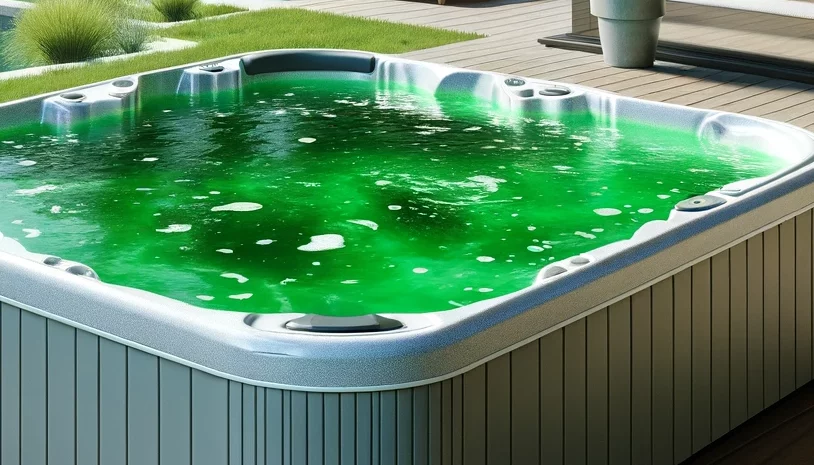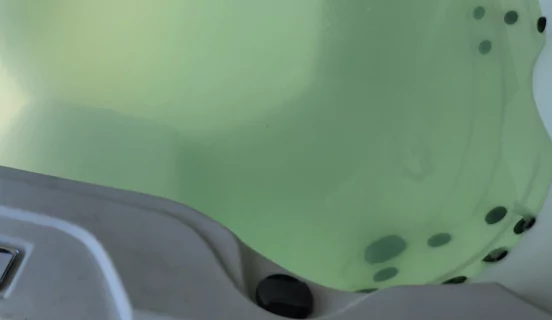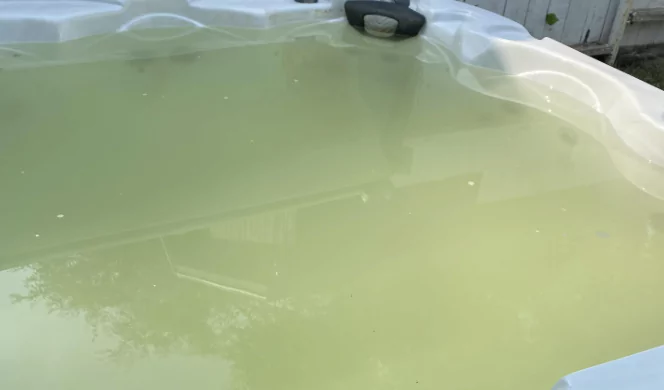Ever noticed your hot tub water turning a bit… green? It’s not exactly the inviting, crystal-clear tub you’d imagine for a relaxing soak, right? Well, you’re not alone.
This green tint is a common headache for many hot tub owners. But here’s some good news: it’s fixable. And not just with a call to the professionals but with your own two hands.
The key? Understanding what causes it and knowing the right steps to clear it up.
So, let’s dive in, shall we? By the end of this guide, you’ll be equipped to tackle that green menace head-on and restore your hot tub to its former glory.
Understanding Why Your Hot Tub Water Turns Green

Algae Growth
First off, let’s talk about algae, which is often the cause of green tub water. This unwelcome visitor finds its way into your hot tub for a few reasons:
- Sunlight exposure: Just like plants, algae love sunlight. It’s their version of a buffet, helping them grow and multiply.
- Warm temperatures: Hot tubs are, well, hot. And that warmth is another tick in the box for algae growth.
- Lack of sanitizer: Without enough sanitizer, algae spores waltz in unchecked and decide to stay.
Metal in the Water
But algae aren’t the only culprits. Metals like copper and iron can also turn your water green. How do they get there? Two main ways:
- Source water: Sometimes, the water you fill your hot tub with brings these metals along for the ride.
- Corrosion: Your hot tub’s components can corrode over time, releasing metals into the water.
Imbalance in Water Chemistry
Lastly, the balance of your water’s chemistry plays a massive role. If your pH, alkalinity, or sanitizer levels are out of whack, it’s like rolling out the green carpet for algae and metal staining. Keeping these levels in check is crucial.
Step-by-Step Guide to Clearing Green Hot Tub Water
Green water is a common issue that can dampen the spirits of any hot tub owner, but, fear not, it’s also a problem that can be solved with a bit of know-how and elbow grease. Here is how:

Testing and Adjusting Water Chemistry
Let’s start with the basics:
- Test your water: Grab a water testing kit from your local pool supply store. You’re looking to check the pH, alkalinity, sanitizer levels, and presence of metals.
- Adjust the levels: Based on your test results, you’ll need to adjust:
- pH: Aim for a range between 7.4 and 7.6.
- Alkalinity: Keep it between 100 and 150 ppm.
- Sanitizer levels: Follow the guidelines for your specific sanitizer type.
Shock Treatment
Next up, shock your hot tub. This isn’t as scary as it sounds. Shocking simply refers to adding a large dose of sanitizer to kill off algae and bacteria. Here’s how:
- Choose your shock: There are different types, but for green water, chlorine-based shock is often recommended.
- Follow the instructions: Each shock product is a bit different, so read and follow the label instructions closely.
Algaecide Use
Algaecides are chemicals specifically designed to combat algae. But timing and dosage are key:
- When to use: After you’ve shocked the water and the algae are weakened.
- How to use: Again, follow the product’s instructions to avoid overuse, which can cause other issues.
Cleaning or Replacing the Filter
Your filter is your hot tub’s first line of defense against impurities:
- Cleaning the filter: Remove the filter and rinse it thoroughly with a hose. For a deeper clean, soak it in a filter cleaning solution, then rinse again.
- Replacing the filter: If cleaning doesn’t do the trick or your filter is showing its age, it might be time for a new one.
Draining and Refilling (If Necessary)
Sometimes, starting fresh is the best approach:
- When to drain: If your water is stubbornly green or if you’ve had repeated algae issues, consider draining.
- How to drain and refill: Turn off the power, connect a hose to the drain valve, and let the water out. Once empty, give your hot tub a thorough clean. Then, refill with fresh water, making sure to treat it according to the steps above.
Preventative Measures to Keep Your Hot Tub Water Clear
The journey to clear, inviting hot tub water is a blend of science, routine, and preventative measures. Here is some expert advice to keep your hot tub clean.

Regular Water Testing and Treatment
Consistent water testing is the cornerstone of hot tub maintenance. It’s not just about keeping the water looking clear; it’s about ensuring it’s safe and healthy for everyone who takes a dip. Here’s how you can make water testing and treatment a breeze:
- Test your water regularly: Aim to test your hot tub water at least twice a week. Use test strips or a liquid test kit to check pH levels, alkalinity, and sanitizer (chlorine or bromine) levels.
- Adjust the chemicals: Based on your test results, you’ll likely need to adjust your water’s chemistry. Here’s a quick guide:
- pH levels should be between 7.2 and 7.8. If it’s too high or too low, use a pH increaser or decreaser.
- Alkalinity helps stabilize pH levels and should be between 80 and 120 ppm (parts per million). Adjust with an alkalinity increaser if it falls below this range.
- Sanitizer levels keep your water disinfected. Chlorine levels should be between 1-3 ppm, and bromine levels should be 3-5 ppm. Adjust accordingly with your chosen sanitizer.
Routine Cleaning
Routine cleaning is just as crucial as chemical maintenance. A clean hot tub and filter can significantly reduce the likelihood of water issues like cloudy water or foaming:
- Clean the hot tub shell: Use a non-abrasive cleaner designed for hot tubs to wipe down the shell. Do this every time you drain your hot tub, which should be every 3 to 4 months.
- Clean or replace the filter: A dirty filter can’t do its job effectively. Rinse your filter with a garden hose every 2 weeks and use a filter cleaner every month. Consider replacing your filter every year or if it shows signs of wear and tear.
- Keep the waterline clean: Oils, lotions, and other contaminants can accumulate at the waterline, leading to scum. Wipe this area regularly with a sponge and hot tub cleaner.
Using a Hot Tub Cover
A hot tub cover isn’t just a nice-to-have; it’s an essential component of water quality maintenance, especially for outdoor hot bath tubs:
- Reduce debris: A cover keeps leaves, bugs, and other outdoor debris out of your hot tub.
- Minimize sunlight exposure: Sunlight can promote algae growth and degrade your sanitizer’s effectiveness. A cover helps protect your water from these effects.
- Retain heat: It also helps in retaining heat, which can save on energy costs.
Key Takeaways
- Regular water testing and chemical adjustments are non-negotiable for healthy water.
- Routine cleaning, including taking care of your filter, plays a big role in preventing water problems.
- A hot tub cover is a must-have for reducing debris, minimizing sunlight exposure, and retaining heat.
Taking immediate action at the first sign of green water and maintaining a regular maintenance routine are key to preventing future issues.
FAQ Section
How often should I test my hot tub water?
Ideally, test your hot tub water twice a week. This frequency helps you stay on top of the water chemistry and adjust as needed to prevent issues.
Can I use pool chemicals in my hot tub?
While some chemicals are used in both pools and hot tubs, it’s crucial to use products specifically designed for hot tubs. Hot tubs have different volume, temperature, and aeration conditions, which can affect how chemicals work. Always read labels to ensure the product is suitable for hot tub use.
How long after treating my hot tub can I use it again?
Wait times vary depending on the treatment. For shock treatments, it’s generally safe to use your hot tub again once the sanitizer level falls within the recommended range (1-3 ppm for chlorine, 3-5 ppm for bromine). This can take anywhere from a few hours to overnight.
What should I do if my hot tub water is still green after treatment?
If your water remains green after following the above steps, consider consulting a professional. Persistent green water could indicate an underlying issue that might require more specialized treatment or equipment.
Final Words
Maintaining clean hot tub water is crucial for the health and enjoyment of all users. It requires a bit of effort and attention to detail but think of this as part of the hot tub ownership experience. With regular maintenance, testing, and a proactive approach to water care, you’ll ensure your hot tub remains a welcoming relaxing spot for years to come.





